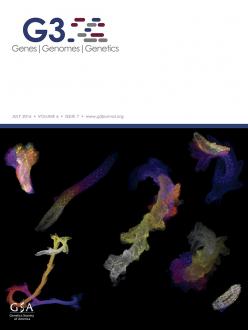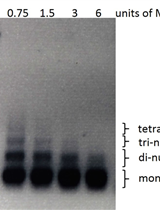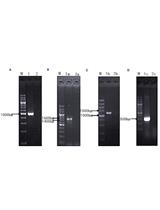- EN - English
- CN - 中文
Method for Multiplexing CRISPR/Cas9 in Saccharomyces cerevisiae Using Artificial Target DNA Sequences
酿酒酵母中使用人工靶DNA序列进行多重CRISPR/ Cas9的方法
发布: 2017年09月20日第7卷第18期 DOI: 10.21769/BioProtoc.2557 浏览次数: 13300
评审: Anonymous reviewer(s)
Abstract
Genome manipulation has become more accessible given the advent of the CRISPR (Clustered Regularly Interspaced Short Palindromic Repeats) editing technology. The Cas9 endonuclease binds a single stranded (single guide) RNA (sgRNA) fragment that recruits the complex to a corresponding genomic target sequence where it induces a double stranded break. Eukaryotic repair systems allow for the introduction of exogenous DNA, repair of existing mutations, or deletion of endogenous gene products. Targeting of Cas9 to multiple genomic positions (termed ‘multiplexing’) is achieved by the expression of multiple sgRNAs within the same nucleus. However, an ongoing concern of the CRISPR field has been the accidental targeting of Cas9 to alternative (‘off-target’) DNA locations within a genome. We describe the use (dubbed Multiplexing of Cas9 at Artificial Loci) of installed artificial Cas9 target sequences into the yeast genome that allow for (i) multiplexing with a single sgRNA; (ii) a reduction/elimination in possible off-target effects, and (iii) precise control of the placement of the intended target sequence(s).
Keywords: CRISPR/Cas9 (CRISPR/Cas9)Background
The CRISPR (Clustered Regularly Interspaced Palindromic Repeats) mechanism has evolved in prokaryotes as a primitive adaptive immune system with the capability to edit any genome with great precision (Jinek et al., 2012; Sorek et al., 2013). This biotechnology requires the use of an endonuclease (Cas9) from S. pyogenes (or othologous species), a single RNA ‘guide’ sequence, and exogenous donor DNA (if needed). In only a few years, CRISPR/Cas9 has been utilized in numerous research laboratories in both academic and industry settings to target DNA sequences within any genome (Doudna and Charpentier, 2014). A variety of research areas including basic research, biofuels, agriculture, genetic disorders, and human pathogens/disease have begun harnessing this technology to address important scientific questions (Estrela and Cate, 2016; Demirci et al., 2017; Men et al., 2017). Recent work in S. cerevisiae has piloted the development of novel CRISPR-based applications including automated genomic engineering (Si et al., 2017), chromosome splitting (Sasano et al., 2016), and the use of nuclease-dead Cas9 (dCas9) to modulate gene expression (Jensen et al., 2017). While this editing system has proved extremely useful, a number of concerns are still being actively addressed. These include off-target effects–the propensity of Cas9 to accidentally target additional genomic positions (Cho et al., 2014; Zhang et al., 2015), the required cloning step(s) needed to generate multiple sgRNAs for Cas9 multiplexing (Ryan and Cate, 2014), and the safety and application of Cas9-based ‘gene drives’ (DiCarlo et al., 2015). Our methodology addresses some of these issues by engineering artificial Cas9 target site(s) within the yeast genome. We describe (i) the selection of the artificial sequences used to multiplex Cas9; (ii) the cloning strategies used to construct plasmids harboring the unique target sites flanking several genes including Cas9 itself; (iii) integration of these constructs into a single yeast genome in successive steps, and (iv) editing using expressed Cas9, sgRNA, and donor DNA to demonstrate proof of concept. This system allows for seamless, marker-less, multi-loci genomic editing with only a single sgRNA. We envision this method could be useful for synthetic genome construction, yeast library generation, and simultaneous manipulation of related genes within a common genetic or signaling pathway.
Materials and Reagents
- Pipette tips (LTS tips 1,000 μl, 250 μl, 20 μl, Mettler-Toledo, Rainin, catalog numbers: GPS-L1000 , GPS-L250 , and GPS-L10 )
- Tubes (Axygen Microtubes 1.5 ml clear, homo-polymer, boil-proof) (Corning, Axygen®, catalog number: MCT-150-C )
- Disposable sterile plastic 15 ml (Corning, Falcon®, catalog number: 352099 ) and 50 ml (Corning, Falcon®, catalog number: 352098 ) conical centrifuge tubes
- Disposable glass test tubes (20 x 150 mm) (Fisher Scientific, catalog number: 14-958K )
- Kimble Kim-Kap test tube closures (Fisher Scientific, catalog number: 14-957-91C)
Manufacturer: DWK Life Sciences, Kimble®, catalog number: 7366020 . - Plastic Petri dish (100 x 15 mm size) (VWR, catalog number: 25384-088 )
- 0.5 mm glass beads (Bio Spec Products, catalog number: 11079105 )
- Yeast strains
- SF838-1Dα (MATα ura3-52 leu2-3,122 his4-519 ade6 pep4-3 gal2) (Univ. of Oregon; Rothman and Stevens, 1986)
- THS4218 (SF838-1Dα; HIS4 his3Δ::HygR) used for in vivo plasmid assembly and recovery (Univ. of California, Berkeley; Finnigan and Thorner, 2015)
- BY4741 (MATα his3∆1 ura3∆0 leu2∆0 met15∆0) (Univ. of California, Berkeley; Brachmann et al., 1998) for construction of all yeast strains tested
- SF838-1Dα (MATα ura3-52 leu2-3,122 his4-519 ade6 pep4-3 gal2) (Univ. of Oregon; Rothman and Stevens, 1986)
- One Shot® TOP10 chemically competent E. coli (Thermo Fisher Scientific, InvitrogenTM, catalog number: C404003 )
Note: See (Finnigan and Thorner, 2015) for propagation and preparation of TOP10 seed cultures. - Plasmid containing prGalL-Cas9-CYC1(t) used as template DNA for construction of Cas9-containing cassettes (Addgene, catalog number: 43804) from (DiCarlo et al., 2013)
- Plasmid containing prSNR52-sgRNA-SUP4(t) (Addgene, catalog number: 43803 ; synthesized de novo by Genscript) (DiCarlo et al., 2013)
- ssDNA: deoxyribonucleic acid sodium salt from salmon testes (boiled for 10 min and cooled on ice prior to each use of a 10 mg/ml stock solution in water) (Sigma-Aldrich, catalog number: D1626 )
- Zymolyase® 100T from Arthrobacter leuteus (25 mg/ml) (Amsbio, catalog number: 120493-1 ) in 50% glycerol stock (certified ACS grade) (Fisher Scientific, catalog number: G33 )
- Appropriate restriction enzyme(s) for digestion
- QIAquick gel extraction kit (QIAGEN, catalog number: 28706 )
- T4 DNA ligase (New England Biolabs, catalog number: M0202 )
- GeneJET plasmid miniprep kit (Thermo Fisher Scientific, Thermo ScientificTM, catalog number: K0503 )
- KOD hot start DNA polymerase (EMD Millipore, catalog number: 71086-3 , distributed by VWR, catalog number: 80511-384)
- Custom DNA oligonucleotide primers (25-100 nmol concentration; Integrated DNA Technologies)
- GeneJet PCR purification kit (Thermo Fisher Scientific, Thermo ScientificTM, catalog number: K0701 )
- Ethidium bromide (Sigma-Aldrich, catalog number: E8751 )
- Agarose powder (U.S. Biotech Sources, catalog number: G01PD-500 )
- Hygromycin, used at 300 μg/ml (Thermo Fisher Scientific, GibcoTM, catalog number: 10687010 )
- G418 sulfate (Geneticin), used at 200 μg/ml (Thermo Fisher Scientific, GibcoTM, catalog number: 11811031 )
- D-(+)-Raffinose pentahydrate (20% stock in water, filter sterilized, not autoclaved) (Sigma-Aldrich, catalog number: R7630 ). Filtered using disposable cellulose nitrate filter (0.2 μm filter size) (Corning, catalog number: 430186 )
- Sucrose (20% stock in water, filter sterilized, not autoclaved) (Fisher Scientific, catalog number: S3 )
- 1 M lithium acetate dihydrate (CH3COOLi·2H2O, reagent grade) (Sigma-Aldrich, catalog number: L6883 )
- 50% PEG: Poly (ethylene glycol), BioXtra avg. molecular weight 3,350 (Sigma-Aldrich, catalog number: P4338 )
- Ampicillin (final concentration of 100 μg/ml) (RPI, catalog number: A40040-100.0 )
- Kanamycin (final concentration of 50 μg/ml) (Thermo Fisher Scientific, GibcoTM, catalog number: 11815024 )
- Yeast extract (BD, BactoTM, catalog number: 212750 )
- Peptone (BD, BactoTM, catalog number: 211677 )
- Dextrose (20% stock in water) (Thermo Fisher Scientific, catalog number: D16 )
- D-(+)-Galactose (20% stock in water, filter sterilized, not autoclaved) (Sigma-Aldrich, catalog number: G0750 )
- Tryptone (BD, BactoTM, catalog number: 211705 )
- Sodium chloride (NaCl, certified ACS grade ≥ 99.0%) (Fisher Scientific, catalog number: S271 )
- Potassium chloride (KCl, BioXtra ≥ 99.0%) (Sigma-Aldrich, catalog number: P9333 )
- Magnesium chloride hexahydrate (MgCl2·6H2O, BioXtra ≥ 99.0%) (Sigma-Aldrich, catalog number: M2670 )
- Magnesium sulfate solution (MgSO4, molecular biology grade) (Sigma-Aldrich, catalog number: M3409 )
- SuperPure agar, bacteriological grade (US Biotech Sources, catalog number: A01PD-500 )
- Yeast nitrogen base minus amino acids and minus ammonium sulfate (Sigma-Aldrich, catalog number: Y1251 )
- Ammonium sulfate ((NH4)2SO4 certified ACS grade ≥ 99.0%) (Fisher Scientific, catalog number: A702 )
- ‘Almost complete’ amino acid mixture
Adenine HCl (Sigma-Aldrich, catalog number: A9795 ), 20 mg/L
Arginine (Sigma-Aldrich, catalog number: A5131 ), 20 mg/L
Tyrosine (Sigma-Aldrich, catalog number: T3754 ), 30 mg/L
Isoleucine (Sigma-Aldrich, catalog number: I2752 ), 30 mg/L
Phenylalanine (Sigma-Aldrich, catalog number: P2126 ), 50 mg/L
Glutamic acid (Sigma-Aldrich, catalog number: G1251 ), 100 mg/L
Aspartic acid (Sigma-Aldrich, catalog number: A9256 ), 100 mg/L
Threonine (Sigma-Aldrich, catalog number: T8625 ), 200 mg/L
Serine (Sigma-Aldrich, catalog number: S4500 ), 400 mg/L
Valine (Sigma-Aldrich, catalog number: V0500 ), 150 mg/L - Methionine (Sigma-Aldrich, catalog number: M9625 )
- Lysine (Sigma-Aldrich, catalog number: L5626 )
- Histidine (Sigma-Aldrich, catalog number: H8125 )
- Leucine (Sigma-Aldrich, catalog number: L8000 )
- Uracil (Sigma-Aldrich, catalog number: U0750 )
- 5-Fluoroorotic acid (5-FOA) (Oakwood Products, catalog number: 003234 )
- Sodium hydroxide (NaOH certified ACS grade ≥ 97.0%) (Fisher Scientific, catalog number: S318 )
- Tris base, molecular biology grade ≥ 99.8% (Fisher Scientific, catalog number: BP152 )
- Glacial acetic acid (certified ACS grade) (Fisher Scientific, catalog number: A38 )
- Ethylenediaminetetraacetic acid (EDTA 99%-101%) (Fisher Scientific, catalog number: S311 )
- Ultrapure sterile water (Millipore Sigma, Milli-Q water purification system)
- YPD liquid media (see Recipes)
- YPGal (see Recipes)
- SOC medium (see Recipes)
- YPD plates (with appropriate drugs optional) (see Recipes)
- Synthetic drop-out plates/media (see Recipes)
- 5-FOA plates (see Recipes)
- LB plates (with appropriate drug included) (see Recipes)
- TAE buffer (see Recipes)
Equipment
- Pipettes (Rainin, Pipet-Lite LTS, 1,000 μl, 250 μl, 20 μl, and 2 μl sizes)
- PCR machine (MJ Research PTC-200 Peltier Thermo Cycler, dual 30-well alpha blocks) (MJ Research, model: PTC-200 )
- Centrifuge (Eppendorf microcentrifuge) (Eppendorf, model: 5415 D , catalog number: 022621408)
- Eppendorf rotor (for 24 x 1.5/2 ml) (Eppendorf, model: F-45-24-11 , catalog number: 022636502)
- Vortexing adaptor (Microtube foam insert for Fisher Vortex Genie 2 mixer) (Scientific Industries, model: Vortex Genie 2 , catalog number: 504-0234-00)
- Ice maker (Hoshizaki American)
- Water bath (Thermomix circulating water bath, Model B, type 852 013/5)
- DNA gel electrophoresis apparatus (HE 33 Mini Submarine Unit) (GE Healthcare, catalog number: 80-6052-45 )
- ChemiDoc UV transilluminator (Bio-Rad Laboratories, model: ChemiDocTM XRS+, catalog number: 1708265 )
- Incubator rotator (Labquake shaker) (Labindustries, model: T-415-110 )
- Incubators (VWR, model: Model 1535 )
- Autoclave (Univ. of California, Barker Hall)
Procedure
文章信息
版权信息
© 2017 The Authors; exclusive licensee Bio-protocol LLC.
如何引用
Giersch, R. M. and Finnigan, G. C. (2017). Method for Multiplexing CRISPR/Cas9 in Saccharomyces cerevisiae Using Artificial Target DNA Sequences. Bio-protocol 7(18): e2557. DOI: 10.21769/BioProtoc.2557.
分类
微生物学 > 微生物遗传学 > DNA > 染色体
分子生物学 > DNA > DNA 克隆
分子生物学 > DNA > 染色体工程
您对这篇实验方法有问题吗?
在此处发布您的问题,我们将邀请本文作者来回答。同时,我们会将您的问题发布到Bio-protocol Exchange,以便寻求社区成员的帮助。
Share
Bluesky
X
Copy link













